Gigabyte ME-B01, ME-B02 Manual

GA-TG965MP-RH
Intel® CoreTM 2 Extreme / CoreTM 2 Duo Intel® Pentium® Processor Extreme Edition
Intel® Pentium® D / Pentium® 4 LGA775 Processor Motherboard
User's Manual
Rev. 100
24MD1-TG965M-01R
*The WEEE marking on the product indicates this product must not be disposed of with user's other household waste and must be handed over to a designated collection point for the recycling of waste electrical and electronic equipment!!
*The WEEE marking applies only in European Union's member states.

Copyright
© 2006 GIGA-BYTE TECHNOLOGY CO., LTD. All rights reserved.
The trademarks mentioned in the manual are legally registered to their respective companies.
Notice
The written content provided with this product is the property of Gigabyte.
No part of this manual may be reproduced, copied, translated, or transmitted in any form or by any means without Gigabyte's prior written permission. Specifications and features are subject to change without prior notice.
Product Manual Classification
In order to assist in the use of this product, Gigabyte has categorized the user manual in the following:
For detailed information related to Gigabyte's unique features, please go to the "Technology Guide" section on Gigabyte's website to read or download the information you need.
For more product details, please visit Gigabyte's website at www.gigabyte.com.tw

Table of Contents
GA-TG965MP-RH Motherboard Layout ........................................................................ |
4 |
|
Block Diagram ................................................................................................................ |
|
5 |
Chapter 1 Hardware Installation .................................................................................... |
7 |
|
1-1 |
Considerations Prior to Installation .................................................................... |
7 |
1-2 |
Feature Summary ............................................................................................ |
8 |
1-3 |
Installation of the CPU and CPU Cooler ....................................................... |
10 |
1-3-1 Installation of the CPU ......................................................................................... |
10 |
|
1-3-2 Installation of the CPU Cooler ............................................................................. |
11 |
|
1-4 |
Installation of Memory .................................................................................... |
12 |
1-5 |
Installation of Expansion Cards ...................................................................... |
14 |
1-6 |
I/O Back Panel Introduction ........................................................................... |
15 |
1-7 |
Connectors Introduction .................................................................................. |
16 |
Chapter 2 BIOS Setup ................................................................................................ |
27 |
|
The Main Menu (For example: BIOS Ver. : D6) ....................................................... |
28 |
|
2-1 |
Standard CMOS Features ............................................................................. |
30 |
2-2 |
Advanced BIOS Features .............................................................................. |
32 |
2-3 |
Integrated Peripherals ..................................................................................... |
34 |
2-4 |
Power Management Setup ............................................................................. |
36 |
2-5 |
PnP/PCI Configurations ................................................................................. |
37 |
2-6 |
PC Health Status ........................................................................................... |
38 |
2-7 |
MB Intelligent Tweaker (M.I.T.) ...................................................................... |
40 |
2-8 |
Load Fail-Safe Defaults ................................................................................... |
41 |
2-9 |
Load Optimized Defaults ................................................................................. |
41 |
2-10 |
Set Supervisor/User Password ..................................................................... |
42 |
2-11 |
Save & Exit Setup ......................................................................................... |
43 |
2-12 |
Exit Without Saving ....................................................................................... |
43 |
- 3 -
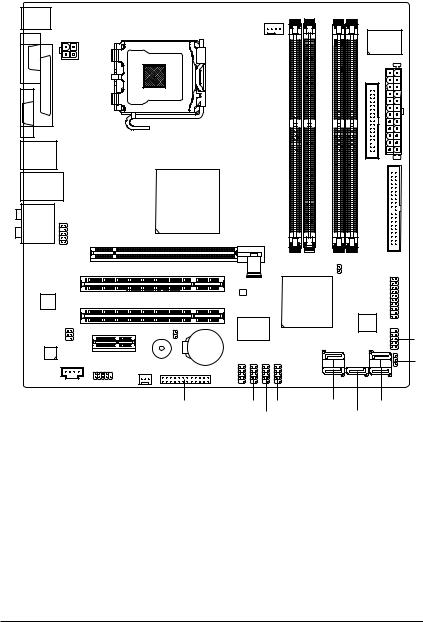
GA-TG965MP-RH Motherboard Layout
KB_MS
ATX_12V
COMA |
|
|
|
LPT |
|
|
LGA775 |
|
|
|
|
VGA |
|
|
|
USB_1394 |
|
|
|
USB_LAN |
|
|
|
|
|
|
Intel® G965 |
AUDIO |
F_AUDIO |
|
|
|
|
|
|
|
|
PCIE_16 |
|
INTEL |
|
PCI1 |
|
|
|
|
|
82566DM |
|
|
|
|
|
PCI2 |
|
SPDIF_IO |
PCIE_1 |
CLR_CMOS |
|
CODEC |
|
||
|
|
BAT |
|
|
|
|
|
|
|
|
BUZZER |
CD_IN |
|
COMB |
SYS _FAN |
|
|
|
|
|
|
|
EXT_BIOS |
|
|
|
(Optional) |
CPU_FAN
|
|
IT8718 |
|
|
FDD ATX |
GA-TG965MP-RH |
|
JIDE |
DDRII1 DDRII2 |
DDRII3 |
DDRII4 |
|
CI |
|
BIOS |
|
TPM |
Intel® ICH8DH |
||
Intel® ICH8R |
(Optional) |
|
VT6308 |
|
1S1P |
|
F_PANEL |
|
|
|
|
F1_1394 |
|
PWR_LED |
F_USB1 F_USB3 |
SATAII45_SB |
SATAII01_SB |
F_USB2 |
SATAII23_SB |
|
Intel® ICH8DH for PCB ver. 1.1. Intel® ICH8R for PCB ver. 2.0.
- 4 -
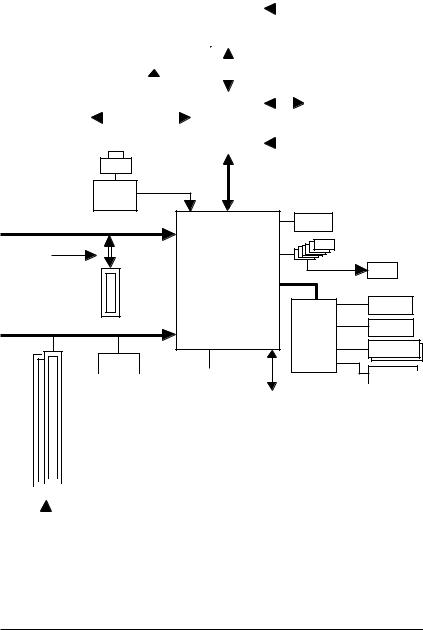
Block Diagram
|
|
|
|
|
|
|
|
|
|
|
|
LGA775 |
|
|
|
CPU CLK+/-(266/200/133 MHz) |
|||||||||||
|
|
|
|
|
|
|
|
|
|
|
|
|
|
|
|
|
|
|
|
|
|
|
|
|
|||
|
|
|
|
|
|
|
|
|
|
|
|
|
|
|
|
|
|
|
|
|
|
|
|||||
|
|
|
|
|
|
|
|
|
|
|
|
Processor |
|
|
|
|
|
|
|
|
|
|
|
|
|
||
|
|
|
|
|
|
|
|
|
|
|
|
|
|
|
|
|
|
|
|
|
|
|
|
|
|
|
|
PCIe CLK |
|
|
|
|
|
|
|
VGA |
|
|
|
Host Interface |
|||||||||||||||
|
|
|
|
|
|
|
|
||||||||||||||||||||
(100 MHz) |
|
|
|
|
|
|
|
|
|
|
|
|
|||||||||||||||
|
|
|
|
|
|
|
|
|
|
|
|
||||||||||||||||
|
|
|
|
|
|
|
|
|
|
|
|
|
|
|
|
|
DDRII 800/667/533 MHz DIMM(Note2) |
||||||||||
|
|
|
|
|
|
|
|
|
|
|
|
|
|
|
|
|
|||||||||||
|
|
|
|
|
|
|
|
|
|
|
|
|
|
|
|
|
|
|
|
|
|
|
|
|
|
|
|
|
|
|
|
|
|
|
|
|
|
|
|
|
|
|
|
|
|
|
|
|
|
|
|||||
|
|
|
|
PCI Express x16 |
|
|
|
|
|
|
|
|
|
|
|
|
|
|
|
|
|
||||||
|
|
|
Intel® |
|
|
|
|
|
|
|
Dual Channel Memory |
|
|
|
|||||||||||||
|
|
|
|
|
|
|
|
|
|
|
|
|
|
|
|
|
|
|
|
|
|||||||
|
|
|
|
|
|
|
|
|
|
|
|
|
|
|
|
|
|
|
|||||||||
|
|
|
|
|
|
|
|
|
|
|
|
G965 |
|
|
|
|
|
|
|
|
|
|
|
|
|
|
|
|
|
|
|
|
|
|
|
|
|
|
|
|
|
|
|
|
|
|
|
|
|
|
|
|
|||
|
|
|
|
|
|
|
|
|
|
|
|
GMCH CLK (266/200/133 MHz) |
|||||||||||||||
|
|
|
|
|
|
|
|
|
|
|
|
||||||||||||||||
|
|
|
|
|
|
|
|
|
|
|
|
|
|
|
|
|
|||||||||||
|
|
|
|
|
|
|
|
|
|
|
|
|
|
|
|
|
|
|
|
|
|
|
|
|
|
|
|
|
|
|
|
|
|
|
|
|
|
|
|
|
|
|
|
|
|
|
|
|
|
|
|
|
|
|
|
|
|
|
|
|
|
|
|
|
|
|
|
|
|
|
|
|
|
|
|
|
|
|
|
|
|
|
|
LAN |
RJ45 |
|
|
|
|
Intel |
|
|
|
82566DM |
|
|
|
|
|
|
|
BIOS |
|
|
x 1 |
|
|
6 SATA 3Gb/s |
|
(Note1) |
|
|
|
PCIe CLK |
|
|
JIDE |
|
|
Intel® ICH8DH |
|
||
|
|
|
||
(100 MHz) |
|
Intel® ICH8R |
|
|
1 PCI Express x1 |
|
|
|
LPT |
PCI Bus |
|
IT8718 |
Floppy |
|
|
|
|
|
|
|
VT6308 |
|
|
COM Ports |
|
|
|
|
|
|
|
|
|
|
|
|
|
|
|
|
|
|
|
|
|
|
|
CODEC |
|
|
|
|
|
|
|
|
|
|
|
|
|
|
|
|
|
|
|
|
||||||
|
|
|
|
|
|
|
|
|
|
|
|
|
|
|
|
|
|
|
|
|
|
|
|
|
|
|
|
|
|
|
|
|
|
|
|
|
|
|||||||
|
|
|
|
|
|
|
|
|
|
|
|
|
|
|
|
|
|
|
|
|
|
|
|
|
|
|
|
|
|
|
|
|
PS/2 KB/Mouse |
|
||||||||||
|
|
|
|
|
|
|
|
|
|
|
IEEE1394a2 |
|
|
SpeakerOut SpeakerOut SpeakerOut MIC Line-Out Line-In |
SPDIFIn SPDIFOut |
|
|
|
|
|
|
|
|
|
|
|
|
|
|
|
||||||||||||||
|
|
|
|
|
|
|
|
|
|
|
|
|
|
|
|
|
|
|
|
|
|
|
|
|||||||||||||||||||||
|
|
|
|
|
|
|
|
|
|
10 USB |
||||||||||||||||||||||||||||||||||
|
|
|
|
|
|
|
|
|
|
|
|
|
|
|
|
|
|
|
|
|
|
|
|
|
|
|
|
|
|
|
||||||||||||||
|
|
|
|
|
|
|
|
|
|
|
|
|
|
|
|
|
|
|
|
|
|
|
|
|
|
|
|
|
|
|
|
|
|
Ports |
||||||||||
|
|
|
|
|
|
|
|
|
|
|
|
|
Surround Center/Subwoofer Side |
|
|
|
|
|
|
|
|
|
|
|
|
|
|
|
|
|
|
|
|
|||||||||||
|
|
|
|
|
|
|
|
|
|
|
|
|
|
|
|
|
|
|
|
|
|
|
|
|
|
|
|
|
|
|
|
|
|
|||||||||||
|
|
2 PCI |
|
|
|
|
|
|
|
|
|
|
|
|
|
|
|
|
|
|
|
|
|
|
||||||||||||||||||||
|
|
|
|
|
|
|
|
|
|
|
|
|
|
|
|
|
|
|
|
|
|
|
|
|
|
|
|
|
|
|
|
|
|
|||||||||||
|
|
|
|
|
|
|
|
|
|
|
|
|
|
|
|
|
|
|
|
|
|
|
|
|
|
|
|
|
|
|
|
|||||||||||||
PCI CLK(33 MHz) |
|
|
|
|
|
|
|
|
|
|
|
|
|
|
|
|
|
|
|
|
||||||||||||||||||||||||
|
|
|
|
|
|
|
|
|
|
|
|
|
|
|
|
|
|
|
|
|
|
|
|
|
|
|
|
|
|
|
|
|
||||||||||||
(Note1)
Intel® ICH8DH for PCB ver. 1.1. ; Intel® ICH8R for PCB ver. 2.0. (Note2)
To use a DDR II 800/667 memory module on the motherboard, you must install an 800 / 1066 MHz FSB processor.
- 5 -

- 6 -

Chapter 1Hardware Installation
1-1 Considerations Prior to Installation
Preparing Your Computer
The motherboard contains numerous delicate electronic circuits and components which can become damaged as a result of electrostatic discharge (ESD). Thus, prior to installation, please follow the instructions below:
1.Please turn off the computer and unplug its power cord.
2.When handling the motherboard, avoid touching any metal leads or connectors.
3.It is best to wear an electrostatic discharge (ESD) cuff when handling electronic components (CPU, RAM).
4.Prior to installing the electronic components, please have these items on top of an antistatic pad or within a electrostatic shielding container.
5.Please verify that the power supply is switched off before unplugging the power supply connector from the motherboard.
Installation Notices
1.Prior to installation, please do not remove the stickers on the motherboard. These stickers are required for warranty validation.
2.Prior to the installation of the motherboard or any hardware, please first carefully read the information in the provided manual.
3.Before using the product, please verify that all cables and power connectors are connected.
4.To prevent damage to the motherboard, please do not allow screws to come in contact with the motherboard circuit or its components.
5.Please make sure there are no leftover screws or metal components placed on the motherboard or within the computer casing.
6.Please do not place the computer system on an uneven surface.
7.Turning on the computer power during the installation process can lead to damage to system components as well as physical harm to the user.
8.If you are uncertain about any installation steps or have a problem related to the use of the product, please consult a certified computer technician.
Instances of Non-Warranty
1.Damage due to natural disaster, accident or human cause.
2.Damage as a result of violating the conditions recommended in the user manual.
3.Damage due to improper installation.
4.Damage due to use of uncertified components.
5.Damage due to use exceeding the permitted parameters.
6.Product determined to be an unofficial Gigabyte product.
English
- 7 - |
Hardware Installation |

English
1-2 |
Feature Summary |
||||
|
|
|
|
||
CPU |
|
|
Supports LGA775 Intel® CoreTM 2 Extreme / CoreTM 2 Duo / Pentium® Proces- |
||
|
|
|
sor Extreme Edition / Pentium® D / Pentium® 4 |
||
|
|
L2 cache varies with CPU |
|||
|
|
|
|||
Front Side Bus |
|
Supports 1066/800/533 MHz FSB |
|||
Chipset |
|
|
Northbridge: Intel® G965 Express Chipset |
||
|
|
Southbridge: Intel® ICH8DH(for PCB ver. 1.1) / ICH8R(for PCB ver. 2.0) |
|||
LAN |
|
|
Onboard Intel 82566DM phy (10/100/1000 Mbit) |
||
Audio |
|
|
Onboard Realtek ALC888 chip |
||
|
|
Supports High Definition Audio |
|||
|
|
Supports 2 / 4 / 6 / 8 channel audio |
|||
|
|
Supports SPDIF In/Out connection |
|||
|
|
Supports CD In connection |
|||
Storage |
|
|
ICH8DH / ICH8R Southbrigde |
||
|
|
|
- 1 FDD connector, allowing connection of 1 FDD device |
||
|
|
|
- 1 JIDE connector, allowing connection of 1 IDE device |
||
|
|
|
- |
5 SATA 3Gb/s connectors (SATAII 0,1, 2, 3,4,5), allowing connection |
|
|
|
|
|
|
of 5 SATA 3Gb/s devices |
|
|
|
- Supports data striping (RAID 0), mirroring (RAID 1), and JBOD for |
||
|
|
|
|
|
Serial ATA |
O.S Support |
|
Microsoft Windows 2000/XP |
|||
Memory |
|
|
4 |
DDRII DIMM memory slots (supports up to 8 GB memory) |
|
|
|
Supports dual channel DDRII 800/667/533 unbuffered DIMMs(Note 1) |
|||
|
|
Supports 1.8V DDRII DIMMs |
|||
|
|
|
|
||
Expanstion Slots |
|
1 |
PCI Express x16 slot |
||
|
|
1 PCI Express x1 slot |
|||
|
|
|
2 |
PCI slots |
|
Internal Connectors |
|
1 24-pin ATX power connector |
|||
|
|
1 4-pin ATX 12V power connector |
|||
|
|
|
1 floppy connector |
||
|
|
|
1 JIDE connector |
||
|
|
|
5 SATA 3Gb/s connectors |
||
|
|
1 CPU fan connector |
|||
|
|
1 system fan connector |
|||
|
|
1 front panel connector |
|||
|
|
1 front audio connector |
|||
|
|
1 CD In connector |
|||
|
|
1 power LED connector |
|||
|
|
3 USB 2.0/1.1 connectors for additional 6 USB 2.0/1.1 ports by cables |
|||
|
|
1 SPDIF In/Out connector |
|||
|
|
1 IEEE1394a connectors for additional 1 ports by cable |
|||
|
|
|
1 COMB connector |
||
|
|
1 TPM connector (Optional) |
|||
|
|
1 EXT BIOS connector (Optional) |
|||
|
|
|
|
|
|
GA-TG965MP-RH Motherboard |
- 8 - |
||||

Rear Panel I/O |
|
1 PS/2 keyboard port |
|
1 PS/2 mouse port |
|
|
|
1 parallel port |
|
|
1 VGA port |
|
1 serial port (COMA) |
|
|
4 USB 2.0/1.1 ports |
|
|
|
1 IEEE1394a port |
|
|
1 RJ-45 port |
|
6 audio jacks (Line In / Line Out / MIC In/Surround Speaker Out (Rear |
|
|
|
Speaker Out)/Center/Subwoofer Speaker Out/Side Speaker Out) |
|
|
|
I/O Control |
|
IT8718 chip |
Hardware Monitor |
|
System voltage detection |
|
CPU / System temperature detection |
|
|
CPU / System fan speed detection |
|
|
|
CPU warning temperature |
|
CPU / System fan failure warning |
|
|
CPU Smart Fan Control |
|
BIOS |
|
1 8 Mbit flash ROM |
|
Use of licensed AWARD BIOS |
|
|
|
|
Additional Features |
|
Supports @BIOS |
|
|
Supports Download Center |
|
|
Supports Q-Flash |
|
Supports Dual BIOS (Optional) |
|
|
Supports EasyTune (Note 2) |
|
|
|
Supports Xpress Recovery2 |
Form Factor |
|
Micro ATX form factor; 24.4cm x 24.4cm |
English
(Note 1) To use a DDR II 800/667 memory module on the motherboard, you must install an 800/ 1066 MHz FSB processor.
(Note 2) EasyTune functions may vary depending on different motherboards.
- 9 - |
Hardware Installation |
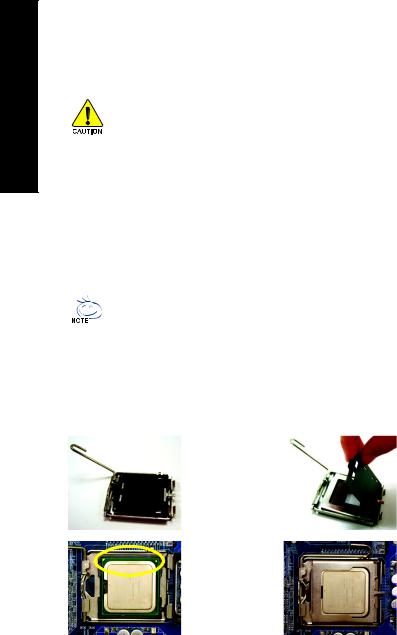
English
1-3 Installation of the CPU and CPU Cooler
Before installing the CPU, please comply with the following conditions:
1.Please make sure that the motherboard supports the CPU.
2.Please take note of the one indented corner of the CPU. If you install the CPU
in the wrong direction, the CPU will not insert properly. If this occurs, please change the insert direction of the CPU.
3.Please add an even layer of heat sink paste between the CPU and heatsink.
4.Please make sure the heatsink is installed on the CPU prior to system use, otherwise overheating and permanent damage of the CPU may occur.
5.Please set the CPU host frequency in accordance with the processor specifications. It is not recommended that the system bus frequency be set beyond hardware specifications since it does not meet the required standards for the peripherals. If you wish to set the frequency beyond the proper specifications, please do so according to your hardware specifications including the CPU, graphics card, memory, hard drive, etc.
HT functionality requirement content :
Enabling the functionality of Hyper-Threading Technology for your computer system requires all of the following platform components:
-CPU: An Intel® Pentium 4 Processor with HT Technology
-Chipset: An Intel® Chipset that supports HT Technology
-BIOS: A BIOS that supports HT Technology and has it enabled
-OS: An operation system that has optimizations for HT Technology
1-3-1 Installation of the CPU
|
|
Metal Lever |
Fig. 1 |
|
Fig. 2 |
|
|
Gently lift the metal |
Remove the plastic |
||
|
|
|
|||
|
|
|
lever located on the |
covering on the CPU |
|
|
|
|
CPU socket to the |
|
socket. |
|
|
|
upright position. |
|
|
|
|
|
Fig. 3 |
|
Fig. 4 |
|
|
|
Notice the small gold |
Once the CPU is |
|
|
|
|
colored triangle |
lo- |
properly inserted, |
|
|
|
cated on the edge of |
please replace the |
|
|
|
|
t h e C P U s o c k e t . |
plastic covering and |
|
|
|
|
Align the indented cor- |
push the metal lever |
|
|
|
|
ner of the CPU with |
back into its original |
|
the triangle and gently insert the CPU into position. |
position. |
||||
(Grasping the CPU firmly between your thumb |
|
||||
and forefinger, carefully place it into the socket in a |
|
||||
straight and downwards motion. Avoid twisting or |
|
||||
bending motions that might cause damage to the |
|
||||
CPU during installation.) |
|
|
|
||
|
|
|
|
|
|
GA-TG965MP-RH Motherboard |
- 10 - |
|
|||

1-3-2 Installation of the CPU Cooler
Male Push Pin
 The top of Female Push Pin
The top of Female Push Pin
Female Push Pin
Fig.1
Please apply an even layer of CPU cooler paste on the surface of the installed CPU.
Fig. 3
Place the CPU cooler atop the CPU and make sure the push pins aim to the pin hole on the motherboard.Pressing down the push pins diagonally.
Fig. 5
Please check the back of motherboard after installing. If the push pin is inserted as the picture, the installation is complete.
Fig. 2
(Turning the push pin along the direction of arrow is to remove the CPU cooler, on the contrary, is to install.) Please note the direction of arrow sign on the male push pin doesn't face inwards before installation. (This instruction is only for Intel boxed fan)
Fig. 4
Please make sure the Male and Female push pin are joined closely. (for detailed installation instructions, please refer to the CPU cooler installation section of the user manual)
Fig. 6
Finally, please attach the power connector of the CPU cooler to the CPU fan header located on the motherboard.
The CPU cooler may adhere to the CPU as a result of hardening of the heat paste. To prevent such an occurrence, it is suggested that either thermal tape rather than heat paste be used for heat dissipation or using extreme care when removing the CPU cooler.
English
- 11 - |
Hardware Installation |
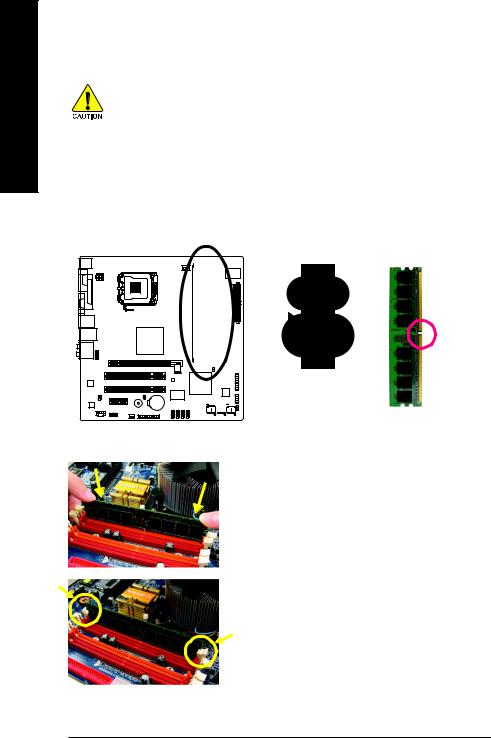
English
1-4 Installation of Memory
Before installing the memory modules, please comply with the following conditions:
1.Please make sure that the memory used is supported by the motherboard. It is
recommended that memory of similar capacity, specifications and brand be used.
2.Before installing or removing memory modules, please make sure that the computer power is switched off to prevent hardware damage.
3.Memory modules have a foolproof insertion design. A memory module can be installed in only one direction. If you are unable to insert the module, please switch the direction.
The motherboard supports DDRII memory modules, whereby BIOS will automatically detect memory capacity and specifications. Memory modules are designed so that they can be inserted only in one direction. The memory capacity used can differ with each slot.
Notch
DDRII
Fig.1
The DIMM socket has a notch, so the DIMM memory module can only fit in one direction. Insert the DIMM memory module vertically into the DIMM socket. Then push it down.
Fig.2
Close the plastic clip at both edges of the DIMM sockets to lock the DIMM module.
Reverse the installation steps when you wish to remove the DIMM module.
GA-TG965MP-RH Motherboard |
- 12 - |

Dual Channel Memory Configuration
The GA-TG965MP-RH supports the Dual Channel Technology. After operat-
ing the Dual Channel Technology, the bandwidth of memory bus will double.



 The GA-TG965MP-RH includes 4 DIMM sockets, and each Channel has two DIMM sockets as following:
The GA-TG965MP-RH includes 4 DIMM sockets, and each Channel has two DIMM sockets as following:
 Channel 0 : DDRII1, DDRII2
Channel 0 : DDRII1, DDRII2
 Channel 1 : DDRII3, DDRII4
Channel 1 : DDRII3, DDRII4
If you want to operate the Dual Channel Technology, please note the following explanations due to the limitation of Intel chipset specifications.
1.Dual Channel mode will not be enabled if only one DDRII memory module is installed.
2.To enable Dual Channel mode with two or four memory modules (it is recommended to use memory modules of identical brand, size, chips, and speed), you must install them into DIMM sockets of the same color.
The following is a Dual Channel Memory configuration table: (DS: Double Side, SS: Single Side, X:Empty)
|
DDRII1 |
DDRII2 |
DDRII3 |
DDRII4 |
2 memory modules |
DS/SS |
X |
DS/SS |
X |
|
X |
DS/SS |
X |
DS/SS |
4 memory modules |
DS/SS |
DS/SS |
DS/SS |
DS/SS |
|
|
|
|
|
(Note) When memory modules of different size and chips are installed, a message which indicates that memory is configured to Flex memory mode operation will appear during POST.
Intel® Flex Memory Technology offers easier upgrades by allowing different memory sizes to be populated and remain in dual-channel mode.
English
- 13 - |
Hardware Installation |
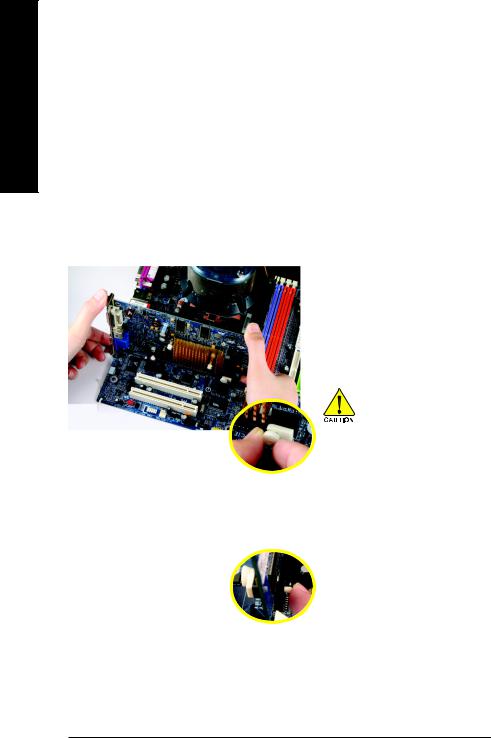
English
1-5 Installation of Expansion Cards
You can install your expansion card by following the steps outlined below:
1.Read the related expansion card's instruction document before install the expansion card into the computer.
2.Remove your computer's chassis cover, screws and slot bracket from the computer.
3.Press the expansion card firmly into expansion slot in motherboard.
4.Be sure the metal contacts on the card are indeed seated in the slot.
5.Replace the screw to secure the slot bracket of the expansion card.
6.Replace your computer's chassis cover.
7.Power on the computer, if necessary, setup BIOS utility of expansion card from BIOS.
8.Install related driver from the operating system.
Installing a PCI Express x16 expansion card:
Please carefully pull out the small whitedrawable bar at the end of the PCI Express x16 slot when you try to install/ uninstall the VGA card. Please align the VGA card to the onboard PCI Express x16 slot and press firmly down on the slot. Make sure your VGA card is locked by the small white-drawable bar.
To install a VGA card or to release an installed card, users can also press the latch on the back of the drawable bar as the picture to the left shows.
GA-TG965MP-RH Motherboard |
- 14 - |
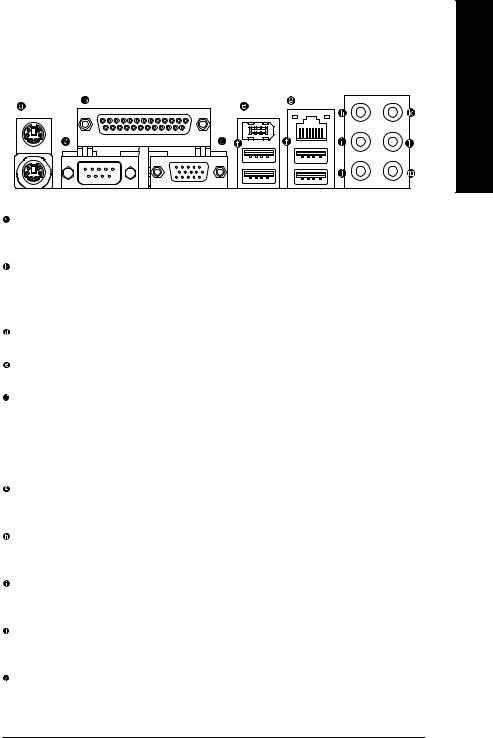
1-6 I/O Back Panel Introduction
English
PS/2 Keyboard and PS/2 Mouse Connector
To install a PS/2 port keyboard and mouse, plug the mouse to the upper port (green) and the keyboard to the lower port (purple).
Parallel Port (LPT)
The parallel port allows connection of a printer, scanner and other peripheral devices.
 Serial Port (COMA)
Serial Port (COMA)
Devices like mouses, modems, and etc. can be connected to Serial port.
VGA Port
Monitor can be connected to VGA port.
IEEE 1394 port
Connectec to IEEE 1394 devices.
USB port
Before you connect your device(s) into USB connector(s), please make sure your device(s) such as USB keyboard, mouse, scanner, zip, speaker...etc. have a standard USB interface. Also make sure your OS supports USB controller. If your OS does not support USB controller, please contact OS vendor for possible patch or driver upgrade. For more information please contact your OS or device(s) vendors.
LAN Port
The provided Internet connection is Gigabit Ethernet, providing data transfer speeds of 10/100/ 1000Mbps.
Center/Subwoofer Speaker Out
The default Center/Subwoofer Speaker Out jack. Center/Subwoofer speakers can be connected to Center/Subwoofer Speaker Out jack.
Surround Speaker Out (Rear Speaker Out)
The default Surround Speaker Out (Rear Speaker Out) jack. Rear surround speakers can be connected to Surround Speaker Out (Rear Speaker Out) jack.
Side Speaker Out
The default Side Speaker Out jack. Surround side speakers can be connected to Side Speaker Out jack.
Line In
The default Line In jack. Devices like CD-ROM, walkman etc. can be connected to Line In jack.
- 15 - |
Hardware Installation |
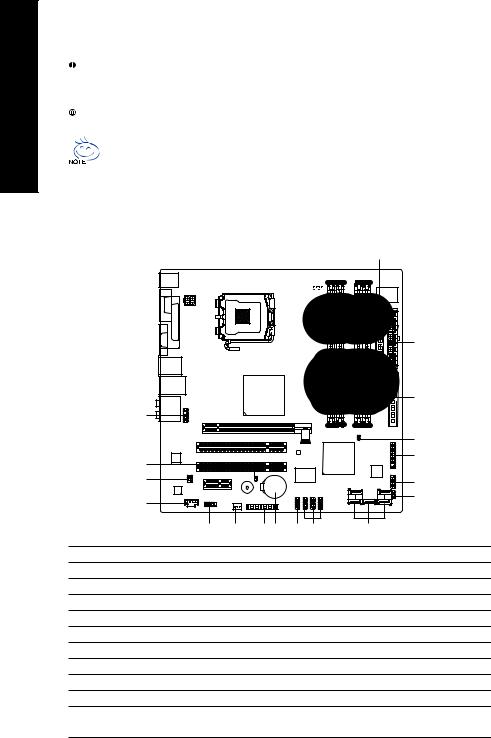
English
Line Out (Front Speaker Out)
The default Line Out (Front Speaker Out) jack. Stereo speakers, earphone or front surround speakers can be connected to Line Out (Front Speaker Out) jack.
MIC In
The default MIC In jack. Microphone must be connected to MIC In jack.
In addition to the default speakers settings, the ~
~ audio jacks can be reconfigured to
audio jacks can be reconfigured to
perform different functions via the audio software. Only microphones still MUST be connected to the default Mic In jack ( ). Please refer to the 2-/4-/6-/8- channel audio setup steps for detailed software configuration information.
). Please refer to the 2-/4-/6-/8- channel audio setup steps for detailed software configuration information.
1-7 Connectors Introduction
1 |
3 |
|
6 |
|
|
|
|
|
|
|
|
|
|
|
|
|
|
|
|
|
|
2 |
|
|
|
|
|
|
5 |
|
10 |
|
|
|
|
|
|
|
|
|
|
|
17 |
|
16 |
|
|
|
|
19 |
|
|
|
|
|
|
|
|
12 |
|
|
|
|
9 |
|
11 |
|
|
|
|
8 |
|
|
|
|
|
|
|
|
15 |
4 |
20 18 |
14 |
13 |
7 |
1) |
ATX_12V |
|
|
11) |
|
CD_IN |
2) |
ATX (Power Connector) |
|
|
12) |
|
SPDIF_IO |
3) |
CPU_FAN |
|
|
13) |
|
F_USB1 / F_USB2 / F_USB3 |
4) |
SYS_FAN |
|
|
14) |
|
F1_1394 |
5) |
JIDE |
|
|
15) |
|
COMB |
6) |
FDD |
|
|
16) |
|
CLR_CMOS |
7) |
SATAII01_SB/SATAII23_SB/SATAII45_SB |
17) |
|
CI |
||
8) |
PWR_LED |
|
|
18) |
|
BATTERY |
9) |
F_PANEL |
|
|
19) |
|
TPM (optional) |
10) |
F_AUDIO |
|
|
20) |
|
EXT_BIOS (optional) |
GA-TG965MP-RH Motherboard |
- 16 - |
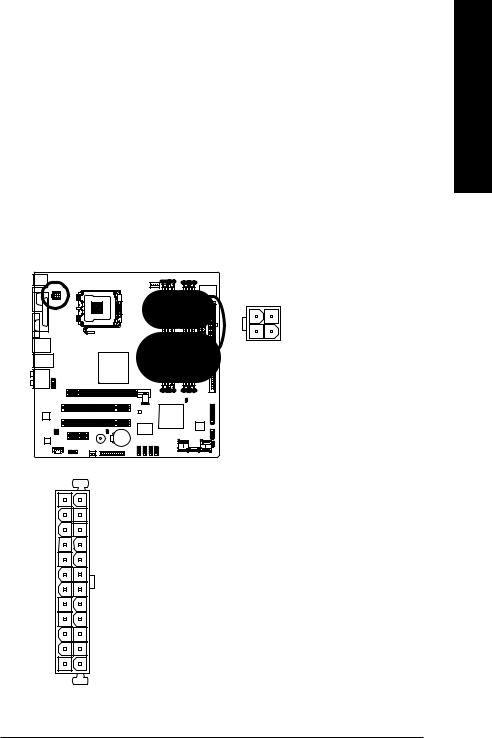
1/2) ATX_12V/ATX (Power Connector)
With the use of the power connector, the power supply can supply enough stable power to all the components on the motherboard. Before connecting the power connector, please make sure that all components and devices are properly installed. Align the power connector with its proper location on the motherboard and connect tightly.
The ATX_12V power connector mainly supplies power to the CPU. If the ATX_12V power connector is not connected, the system will not start.
Caution!
Please use a power supply that is able to handle the system voltage requirements. It is recommended that a power supply that can withstand high power consumption be used (300W or greater). If a power supply is used that does not provide the required power, the result can lead to an unstable system or a system that is unable to start.
If you use a 24-pin ATX power supply, please remove the small cover on the power connector on the motherboard before plugging in the power cord ; otherwise, please do not remove it.
4 |
2 |
Pin No. |
Definition |
|
|
1 |
GND |
|
|
2 |
GND |
3 |
1 |
3 |
+12V |
|
|
4 |
+12V |
English
12 |
24 |
Pin No. |
Definition |
Pin No. |
Definition |
|
1 |
3.3V |
13 |
3.3V |
|||
|
|
|||||
|
|
2 |
3.3V |
14 |
-12V |
|
|
|
3 |
GND |
15 |
GND |
|
|
|
4 |
+5V |
16 |
PS_ON(soft On/Off) |
|
|
|
5 |
GND |
17 |
GND |
|
|
|
6 |
+5V |
18 |
GND |
|
|
|
7 |
GND |
19 |
GND |
|
|
|
8 |
Power Good |
20 |
-5V |
|
|
|
9 |
5V SB(stand by +5V) |
21 |
+5V |
|
|
|
10 |
+12V |
22 |
+5V |
|
|
|
11 |
+12V(Only for 24-pin ATX) |
23 |
+5V (Only for 24-pin ATX) |
|
1 |
13 |
12 |
3.3V(Only for 24-pin ATX) |
24 |
GND(Only for 24-pin ATX) |
- 17 - |
Hardware Installation |
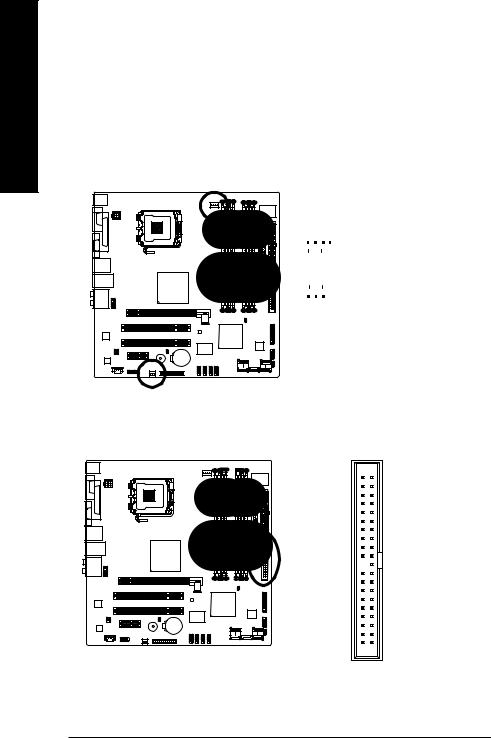
English
3/4) CPU_FAN / SYS_FAN (Cooler Fan Power Connector)
The cooler fan power connector supplies a +12V power voltage via a 3-pin / 4-pin power connector and possesses a foolproof connection design.
Most coolers are designed with color-coded power connector wires. A red power connector wire indicates a positive connection and requires a +12V power voltage. The black connector wire is the ground wire (GND).
Remember to connect the CPU/system fan cable to the CPU_FAN/SYS_FAN connector to prevent CPU damage or system hanging caused by overheating.
1 |
|
|
|
|
|
|
Pin No. |
Definition |
|
|
|
|
|
|
|
1 |
GND |
|
|
|
|
|
|
|||
|
CPU_FAN |
|||||||
|
|
2 |
+12V |
|||||
|
|
|
|
|
|
|
||
|
|
|
|
|
|
|
3 |
Sense |
1 |
|
|
|
|
|
|
4 |
Speed Control |
|
|
|
|
|
|
|
(Only for CPU_FAN) |
|
|
|
|
|
|
|
|
|
|
|
SYS_FAN |
|
|
|||||
|
|
|
|
|||||
|
|
|
|
|||||
5)JIDE
An IDE device connects to the computer via the JIDE connector. (only support primary one device)
40 39
2 1
GA-TG965MP-RH Motherboard |
- 18 - |
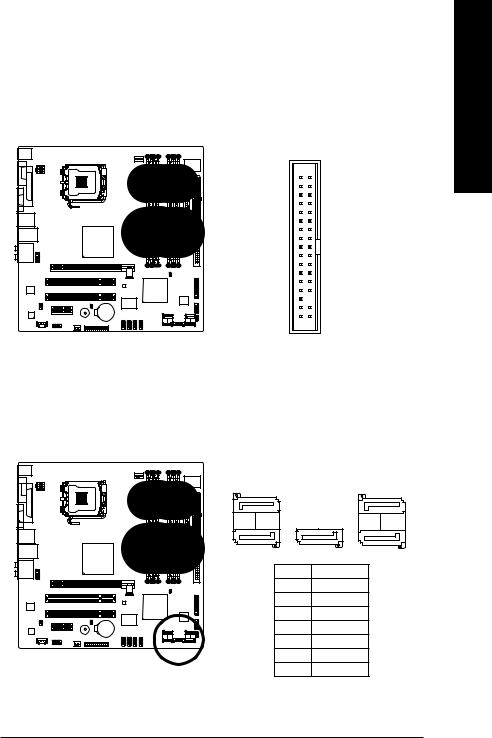
6)FDD (FDD Connector)
The FDD connector is used to connect the FDD cable while the other end of the cable connects to the FDD drive. The types of FDD drives supported are: 360KB, 720KB, 1.2MB, 1.44MB and 2.88MB. Before attaching the FDD cable, please take note of the foolproof groove in the FDD connector.
34 33
2 1
7)SATAII01_SB / SATAII23_SB / SATAII45_SB
(SATA 3Gb/s Connector, Controlled by Intel ICH8DH/ ICH8R)
SATA 3Gb/s can provide up to 300MB/s transfer rate. Please refer to the BIOS setting for the SATA 3Gb/s and install the proper driver in order to work properly.
|
SATAII5 |
|
|
SATAII1 |
7 |
|
|
|
1 |
1 |
1 |
|
7 |
7 |
|
SATAII4 |
SATAII2 |
SATAII0 |
|
|
Pin No. |
Definition |
|
|
|
1 |
|
GND |
|
|
2 |
|
TXP |
|
|
3 |
|
TXN |
|
|
4 |
|
GND |
|
|
5 |
|
RXN |
|
|
6 |
|
RXP |
|
|
7 |
|
GND |
|
English
- 19 - |
Hardware Installation |
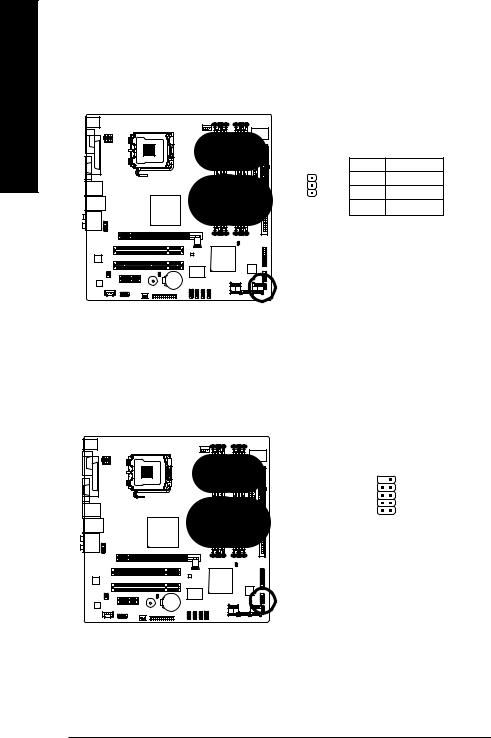
English
8)PWR_LED
The PWR_LED connector is connected with the system power indicator to indicate whether the system is on/off. It will blink when the system enters suspend mode.
|
Pin No. |
Definition |
|
1 |
MPD+ |
1 |
2 |
MPD- |
|
3 |
MPD- |
9)F_PANEL (Front Panel Jumper)
Please connect the power LED, PC speaker, reset switch and power switch etc of your chassis front panel to the F_PANEL connector according to the pin assignment below.
|
10 |
9 |
|
|
|
|
|
|
|||||||||
|
GND |
|
|
|
|
|
|
|
|
|
RESET |
||||||
|
|
|
|
|
|
|
GND |
||||||||||
|
PWRSW |
|
|
|
|
|
|
|
|
|
|
|
|||||
|
|
|
|
|
|
|
|
|
|
||||||||
|
MSG- |
|
|
|
|
|
|
|
|
HD- |
|
|
|
||||
|
MSG+ |
|
|
|
|
|
|
|
|
|
|
|
HD+ |
||||
|
|
|
|
|
|
|
|
|
|
|
|||||||
|
2 |
1 |
|
|
|
|
|
|
|||||||||
|
|
|
|
|
|
|
|
|
|
|
|
|
|
|
|
|
|
Pin No. |
Definition |
|
Pin No. |
|
|
Definition |
|||||||||||
1 |
HD_LED+ |
2 |
|
|
|
MSGLED+ |
|||||||||||
3 |
HD_LED- |
|
|
|
4 |
|
|
|
MSGLED- |
||||||||
5 |
GND |
|
|
|
6 |
|
|
|
PWRSW |
||||||||
7 |
RESET |
8 |
|
|
|
GND |
|||||||||||
9 |
NC |
10 |
|
|
|
||||||||||||
GA-TG965MP-RH Motherboard |
- 20 - |
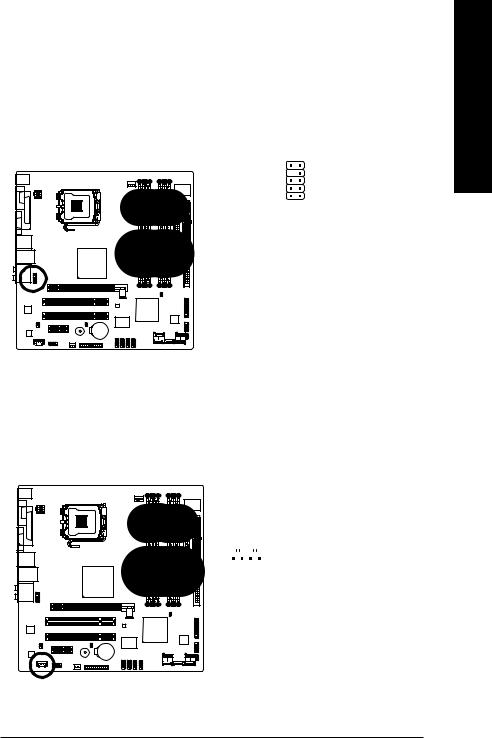
10)F_AUDIO (Front Audio Connector)
This connector supports either HD (High Definition) or AC97 front panel audio module. If you wish to use the front audio function, connect the front panel audio module to this connector. Check the pin assignments carefully while you connect the front panel audio module. Incorrect connection between the module and connector will make the audio device unable to work or even damage it. For optional front panel audio module, please contact your chassis manufacturer.
|
10 |
9 |
|
2 |
1 |
HD Audio: |
|
|
Pin No. |
Definition |
|
1 |
MIC2_L |
|
2 |
GND |
|
3 |
MIC2_R |
|
4 |
-ACZ_DET |
|
5 |
LINE2_R |
|
6 |
FSENSE1 |
|
7 |
FAUDIO_JD |
|
8 |
No Pin |
|
9 |
LINE2_L |
|
10 |
FSENSE2 |
|
AC'97 Audio:
Pin No. |
Definition |
1 |
MIC |
2 |
GND |
3 |
MIC Power |
4 |
NC |
5 |
Line Out (R) |
6 |
NC |
7 |
NC |
8 |
No Pin |
9 |
Line Out (L) |
10 |
NC |
11)CD_IN (CD In Connector)
Connect CD-ROM or DVD-ROM audio out to the connector.
|
|
|
|
|
|
|
Pin No. |
Definition |
1 |
|
|
|
|
|
|
1 |
CD-L |
|
|
|
|
|
|
|||
|
|
|
|
|
|
2 |
GND |
|
|
|
|
|
|
|
|
||
|
|
|
|
|
|
|
3 |
GND |
|
|
|
|
|
|
|
4 |
CD-R |
|
|
|
|
|
|
|
|
|
English
- 21 - |
Hardware Installation |
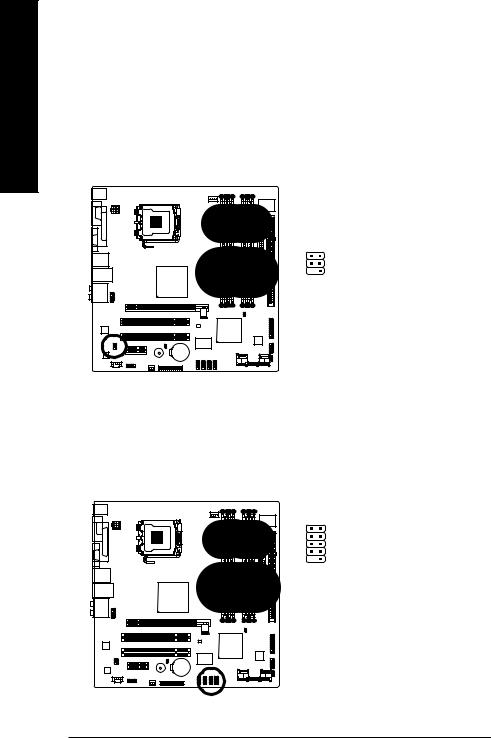
English
12)SPDIF_IO (SPDIF In/Out)
The SPDIF output is capable of providing digital audio to external speakers or compressed AC3 data to an external Dolby Digital Decoder. Use this feature only when your stereo system has digital input function. Use SPDIF IN feature only when your device has digital output function. Be careful with the polarity of the SPDIF_IO connector. Check the pin assignment carefully while you connect the SPDIF cable, incorrect connection between the cable and connector will make the device unable to work or even damage it. For optional SPDIF cable, please contact your local dealer.
|
|
Pin No. |
Definition |
|
|
1 |
Power |
6 |
5 |
2 |
No Pin |
2 |
1 |
3 |
SPDIF |
|
|
4 |
SPDIFI |
|
|
5 |
GND |
|
|
6 |
GND |
13)F_USB1 / F_USB2 / F_USB3 (Front USB Connectors)
Be careful with the polarity of the front USB connector. Check the pin assignment carefully while you connect the front USB cable, incorrect connection between the cable and connector will make the device unable to work or even damage it. For optional front USB cable, please contact your local dealer.
1 |
2 |
Pin No. |
Definition |
|
1 |
Power (5V) |
|||
|
|
|||
9 |
10 |
2 |
Power (5V) |
|
3 |
USB DX- |
|||
|
|
|||
|
|
4 |
USB Dy- |
|
|
|
5 |
USB DX+ |
|
|
|
6 |
USB Dy+ |
|
|
|
7 |
GND |
|
|
|
8 |
GND |
|
|
|
9 |
No Pin |
|
|
|
10 |
NC |
GA-TG965MP-RH Motherboard |
- 22 - |
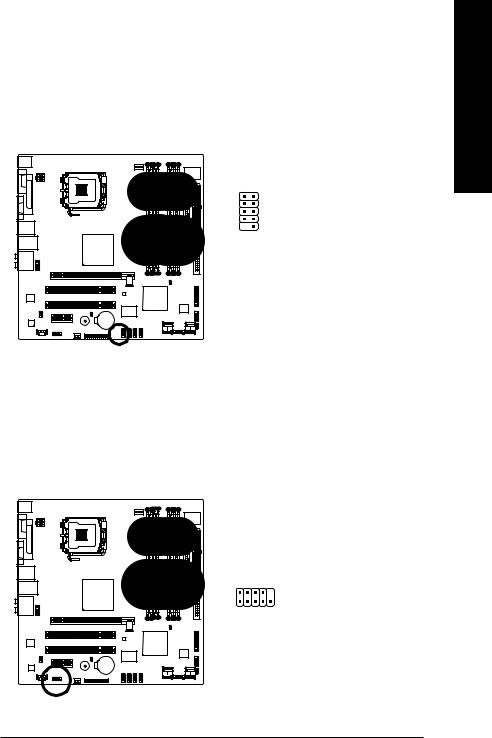
14)F1_1394 (IEEE 1394 Connector)
Serial interface standard set by Institute of Electrical and Electronics Engineers, which has features like high speed, highbandwidth and hot plug. Be careful with the polarity of the IEEE1394 connector. Check the pin assignment carefully while you connect the IEEE1394 cable, incorrect connection between the cable and connector will make the device unable to work or even damage it. For optional IEEE1394 cable, please contact your local dealer.
|
|
Pin No. |
Definition |
|
|
|
1 |
TPA+ |
|
1 |
2 |
2 |
TPA- |
|
3 |
GND |
|||
|
|
|||
9 |
10 |
4 |
GND |
|
5 |
TPB+ |
|||
|
|
|||
|
|
6 |
TPB- |
|
|
|
7 |
Power (12V) |
|
|
|
8 |
Power (12V) |
|
|
|
9 |
No Pin |
|
|
|
10 |
GND |
|
|
|
|
|
English
15)COMB (COMB Connector)
Be careful with the polarity of the COMB connector. Check the pin assignments while you connect the COMB cable. Please contact your nearest dealer for optional COMB cable.
|
|
Pin No. |
Definition |
||
|
|
1 |
NDCDB- |
|
|
|
|
2 |
NSINB |
|
|
|
|
3 |
NSOUTB |
|
|
2 |
10 |
4 |
NDTRB- |
|
|
5 |
GND |
||||
|
|
||||
1 |
9 |
6 |
NDSRB- |
|
|
7 |
NRTSB- |
|
|||
|
|
8 |
NCTSB- |
|
|
|
|
9 |
NRIB- |
|
|
|
|
10 |
No Pin |
|
|
|
|
|
|
|
|
- 23 - |
Hardware Installation |
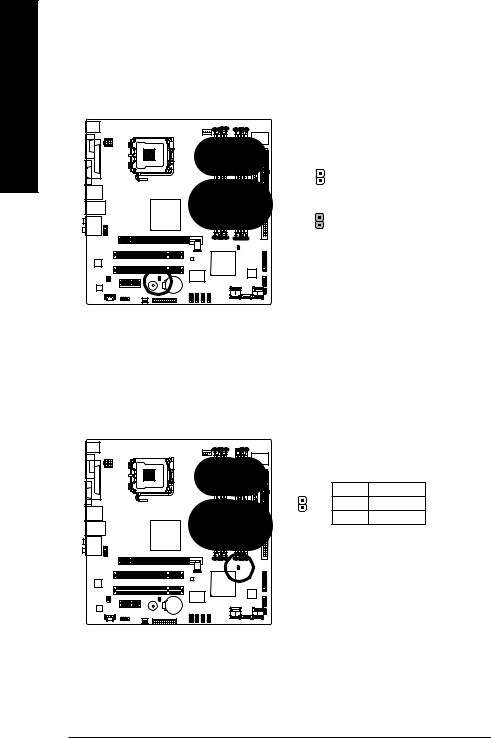
English
16)CLR_CMOS (Clear CMOS)
You may clear the CMOS data to its default values by this header. To clear CMOS, temporarily short the two pins. Default doesn't include the jumper to avoid improper use of this header.
Open: Normal
Short: Clear CMOS
17)CI (Chassis Intrusion, Case Open)
This 2-pin connector allows your system to detect if the chassis cover is removed. You can check the "Case Opened" status in BIOS Setup.
|
Pin No. |
Definition |
|
1 |
1 |
Signal |
|
2 |
GND |
||
|
GA-TG965MP-RH Motherboard |
- 24 - |
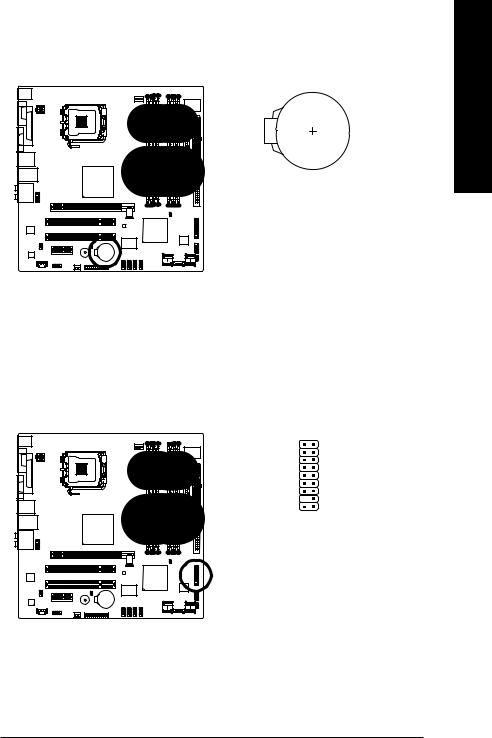
18) BATTERY
 Danger of explosion if battery is incorrectly replaced.
Danger of explosion if battery is incorrectly replaced.
 Replace only with the same or equivalent type recom mended by the manufacturer.
Replace only with the same or equivalent type recom mended by the manufacturer.
 Dispose of used batteries according to the manufacturer's instructions.
Dispose of used batteries according to the manufacturer's instructions.
If you want to erase CMOS...
1. Turn off the computer and unplug the power cord.
2. Gently take out the battery and put it aside for about one minute. (Or you can use a metal object to connect the positive and negative pins in the battery holder to makethem short for five seconds.)
3. Re-install the battery.
4. Plug the power cord in and turn on the computer.
19) TPM (Trust Platform Module) (Optional)
20  19
19
|
2 |
1 |
|
|
|
|
|
Pin No. |
Definition |
Pin No. |
Definition |
1 |
LCLK |
11 |
LAD0 |
2 |
GND |
12 |
GND |
3 |
LFRAME |
13 |
RSVO |
4 |
No Pin |
14 |
RSV1 |
5 |
LRESET |
15 |
SB3V |
6 |
VCC5 |
16 |
SERIRQ |
7 |
LAD3 |
17 |
GND |
8 |
LAD2 |
18 |
CLKRUN |
9 |
VCC3 |
19 |
LPCPD |
10 |
LAD1 |
20 |
RSV2 |
English
- 25 - |
Hardware Installation |
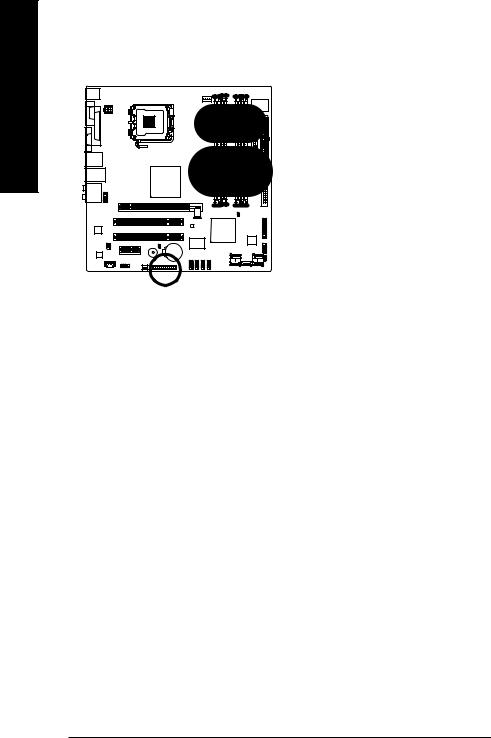
English
20) EXT_BIOS (Dual BIOS connector) (Optional)
GA-TG965MP-RH Motherboard |
- 26 - |

Chapter 2 BIOS Setup
BIOS (Basic Input and Output System) includes a CMOS SETUP utility which allows user to configure required settings or to activate certain system features.
The CMOS SETUP saves the configuration in the CMOS SRAM of the motherboard.
When the power is turned off, the battery on the motherboard supplies the necessary power to the CMOS SRAM.
When the power is turned on, pushing the <Del> button during the BIOS POST (Power-On Self Test) will take you to the CMOS SETUP screen. You can enter the BIOS setup screen by pressing "Ctrl + F1".
If you wish to upgrade to a new BIOS, either Gigabyte's Q-Flash or @BIOS utility can be used. Q-Flash allows the user to quickly and easily update or backup BIOS without entering the operating system.
@BIOS is a Windows-based utility that does not require users to boot to DOS before upgrading BIOS but directly download and update BIOS from the Internet.
CONTROL KEYS
< >< >< >< |
> Move to select item |
<Enter> |
Select Item |
<Esc> |
Main Menu - Quit and not save changes into CMOS Status Page Setup Menu |
|
and Option Page Setup Menu - Exit current page and return to Main Menu |
<Page Up> |
Increase the numeric value or make changes |
<Page Down> |
Decrease the numeric value or make changes |
<F1> |
General help, only for Status Page Setup Menu and Option Page Setup Menu |
<F2> |
Item Help |
<F5> |
Restore the previous CMOS value from CMOS, only for Option Page Setup |
|
Menu |
<F6> |
Load the fail-safe default CMOS value from BIOS default table |
<F7> |
Load the Optimized Defaults |
<F8> |
Dual BIOS (Optional) / Q-Flash utility |
<F9> |
System Information |
<F10> |
Save all the CMOS changes, only for Main Menu |
Main Menu
The on-line description of the highlighted setup function is displayed at the bottom of the screen.
Status Page Setup Menu / Option Page Setup Menu
Press F1 to pop up a small help window that describes the appropriate keys to use and the possible selections for the highlighted item. To exit the Help Window press <Esc>.
Because BIOS flashing is potentially risky, please do it with caution and avoid inadequate operation that may result in system malfunction.
English
- 27 - |
BIOS Setup |
